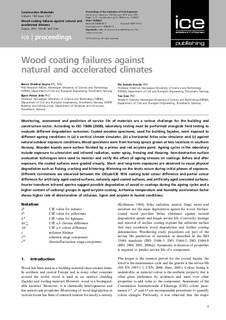| dc.contributor.author | Gupta, Barun Shankar | |
| dc.contributor.author | Jelle, Bjørn Petter | |
| dc.contributor.author | Hovde, Per Jostein | |
| dc.contributor.author | Gao, Tao | |
| dc.date.accessioned | 2017-10-06T07:17:19Z | |
| dc.date.available | 2017-10-06T07:17:19Z | |
| dc.date.created | 2014-07-29T02:26:01Z | |
| dc.date.issued | 2015 | |
| dc.identifier.citation | Proceedings of the Institution of Civil Engineers : Construction Materials. 2015, 168 (1), 3-15. | nb_NO |
| dc.identifier.issn | 1747-650X | |
| dc.identifier.uri | http://hdl.handle.net/11250/2458833 | |
| dc.description.abstract | Monitoring, assessment and prediction of service life of materials are a serious challenge for the building and construction sector. According to ISO 15686 (2008), laboratory testing must be performed alongside field testing to evaluate different degradation outcomes. Coated wooden specimens, used for building façades, were exposed to different ageing conditions in (a) a vertical climate simulator, (b) a horizontal Atlas solar simulator and (c) against natural outdoor exposure conditions. Wood specimens were from Norway spruce grown at two locations in southern Norway. Wooden boards were surface finished by a primer and red acrylate paint. Ageing cycles in the laboratory include exposure to ultraviolet and infrared radiation, water spray, freezing and thawing. Non-destructive surface evaluation techniques were used to monitor and verify the effect of ageing stresses on coatings. Before and after exposure, the coated surfaces were graded visually. Short- and long-term exposures are observed to cause physical degradation such as flaking, cracking and blistering. Blistering on the knots occurs during initial phases of exposure. Different correlations are observed between the CIELab/CIE 1976 coating total colour difference and partial colour difference for artificially aged coated surfaces, naturally aged coated surfaces, and artificially aged uncoated surfaces. Fourier transform infrared spectra suggest possible degradation of wood or coatings during the ageing cycles and a higher content of carbonyl groups in aged acrylate coating. Arrhenius temperature and humidity acceleration factor shows higher rate of deterioration of cellulose, lignin and acrylate in humid conditions. | nb_NO |
| dc.language.iso | eng | nb_NO |
| dc.publisher | Thomas Telford (ICE Publishing) | nb_NO |
| dc.title | Wood coating failures against natural and accelerated climates | nb_NO |
| dc.type | Journal article | nb_NO |
| dc.type | Peer reviewed | nb_NO |
| dc.description.version | publishedVersion | nb_NO |
| dc.source.pagenumber | 3-15 | nb_NO |
| dc.source.volume | 168 | nb_NO |
| dc.source.journal | Proceedings of the Institution of Civil Engineers : Construction Materials | nb_NO |
| dc.source.issue | 1 | nb_NO |
| dc.identifier.doi | 10.1680/coma.13.00022 | |
| dc.identifier.cristin | 1144562 | |
| dc.description.localcode | Published with permission by the ICE | nb_NO |
| cristin.unitcode | 194,64,35,0 | |
| cristin.unitname | Institutt for bygg, anlegg og transport | |
| cristin.ispublished | true | |
| cristin.fulltext | original | |
| cristin.qualitycode | 1 | |
